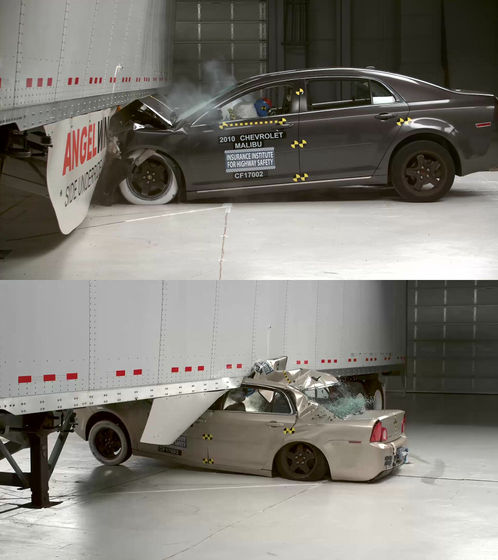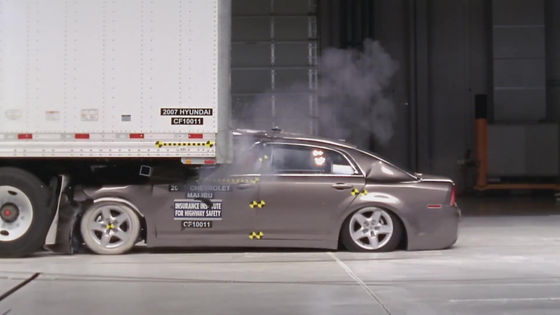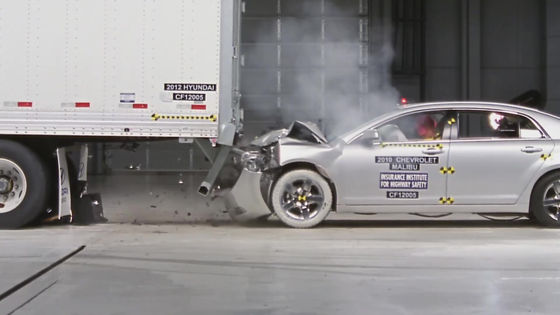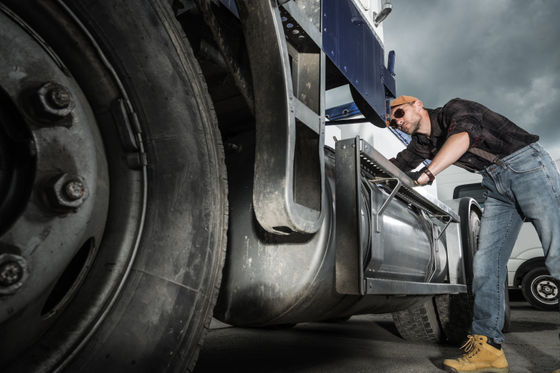Regulators have neglected ``simple measures'' to prevent tragic accidents crushed by large trucks for many years

Although the number of casualties from traffic accidents in the form of 'underride' in which a passenger car or the like slips under the body of a truck can be reduced simply by adding a simple safety device to the truck, the regulatory authorities A joint interview between the non-profit news agency ProPublica and the American TV program FRONTLINE revealed the fact that they ignored the problem and did not take any measures.
How Regulators Failed to Act to Prevent Underride Crashes — ProPublica
The image posted at the top of the article is a scene photo showing the state of the underride accident that occurred in Texas, USA in 2017. Ricardo Marcos (right), driving a Hyundai Elantra at 40 miles per hour (about 64 kilometers per hour), was on his way home when he was rear-ended by a large truck that suddenly joined him from a side road and died. rice field.

According to the coroner's report, the clash broke Marcos' rib and ruptured his liver and spleen. His neck was also broken, and the frontal lobe of his brain was damaged. Local police investigators charged the driver with manslaughter, blaming the truck for the crash, but the charges were eventually dropped.
Such tragic accidents are not uncommon. Hundreds of people die each year in the United States alone due to underriding, in which cars, SUVs, etc. crawl under heavy trucks.
The risk of underriding can be reduced simply by attaching steel guards called 'underride guards' to the rear and both sides of the truck. However, the obligatory installation of underride guards is progressing slowly.

ProPublica and FRONTLINE have obtained and reviewed thousands of pages of government documents reporting on underride accidents since the 1960s. As a result, the road safety authority, the Department of Transportation Highway Traffic Safety Administration (NHTSA), has long ignored the results of credible scientific studies and failed to take simple steps to mitigate the danger of underriding. rice field.
One of the reasons NHTSA was unable to act was that it didn't know how many people were suffering from this accident. In 2023, NHTSA finally publicly admitted that it had not been able to grasp the exact situation. According to the statistical information collected by NHTSA in this way, more than 400 people will die in underride accidents in 2021. Experts say the actual death toll may be higher.
Regulators also struggled with resistance from the trucking industry. For example, in the 1980s, the truck industry estimated that a rear bumper (rear underride guard) would cost $127 per vehicle, and industry lobbyists said, 'Safety measures It would be prohibitively expensive and would permanently damage the American economy.'

Former NHTSA executive David Friedman said: ``The NHTSA has been trying for decades to do something about underriding fatalities, but it has failed to do so. Part of it, I think, is that industry continues to curb and water down the efforts of the authorities.When it comes to making rules to deal with problems like underriding, NHTSA staff have too many A hurdle stands in our way,” he said.
Modern automobiles are equipped with a number of meticulously designed safety features. For example, bumpers and crumple zones (crushable zones) intended to absorb kinetic energy and reduce impact, and airbags to protect the driver and passengers.
However, the bottom of a typical semi-trailer is about 4 feet above the road surface, rendering these safety techniques useless. Therefore, the impact of the collision hits the windshield directly, the pillars that support the roof of the car break, and the lower part of the trailer crushes the driver's and passenger's seats. In many cases, the airbags don't even deploy.
Below is a crash test that compares the case with an underride guard (top) and the case with only a windshield plate (bottom). You can see that the damage in the space where people are riding is completely different.

This is not to say that efforts to popularize underride guards have not been made at all. In 1967, when Hollywood star Jane Mansfield died in an underride accident, it was compulsory to install an underride guard (the name at that time was a rear guard) at the rear of a large truck.
However, regulations were lax and there were no standards for the size and strength of rear guards, so rear guards could easily break in the event of a rear-end collision, and had little effect in preventing underride.
The following is the situation when verifying the effect of the underride guard with low strength.

It doesn't make much sense because it broke and came off at the same time as the collision.

On the other hand, in the case of a strong underride guard, the driver's seat of the car that was rear-ended was safe, thanks to the fact that the body of the passenger car was prevented from crawling under the truck.

The American Trucking Association (ATA), which has long opposed regulation of rear underride guards, has softened its stance in recent years in favor of the regulation. However, industry groups, including ATA, remain strongly opposed to underride guards mounted on the side of the vehicle.
Lewi Pew, a former truck driver himself and vice president of the Owner-Operator Independent Drivers Association, an organization representing individual drivers and small trucking companies, said, 'As someone who has actually driven a truck, Let me tell you, I do believe there are certain cases, certain situations where side under ride guards can work and save lives, but side under ride guards cost lives. There will be examples,' he said, showing a cautious view of the need for an underride guard.
There's a reason truck drivers are distrustful of government policy and new technology. For example, in 1975 the NHTSA established regulations requiring anti-lock brakes on heavy trucks and trailers, but the new braking system was later found to be faulty and prone to failure, prompting truck drivers to stop. I experienced a situation where I had no choice but to lose it and fall to the side of the road.
Pugh also worries that the cost of underride guards, if made mandatory, will hit independent truck drivers and small businesses hard. 'It's all about research, so don't turn truck drivers and shipping companies into guinea pigs,' Pugh said.

Because of these concerns, mandatory underride guarding becomes a tug-of-war between cost and lives saved. NHTSA has calculated that installing underride guards on all new semitrailers in the United States would cost more than $778 million and would prevent only 17.2 deaths annually. matter.
However, some experts are not convinced by this estimate. 'The realistic number of lives saved by side underride guards is 159 to 217 per year, much higher than the NHTSA findings,' said Matt Bramborough, a researcher at the Insurance Institute for Traffic Safety and Vehicle Research Center. High,' he said, adding, 'NHTSA needs to take this issue more seriously.'
Related Posts:
in Ride, Posted by log1l_ks







